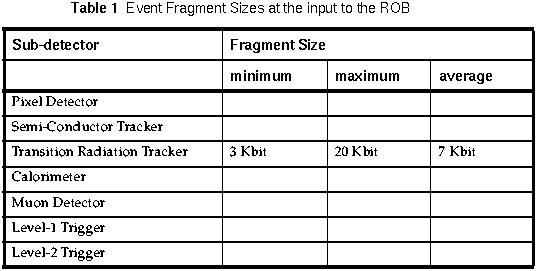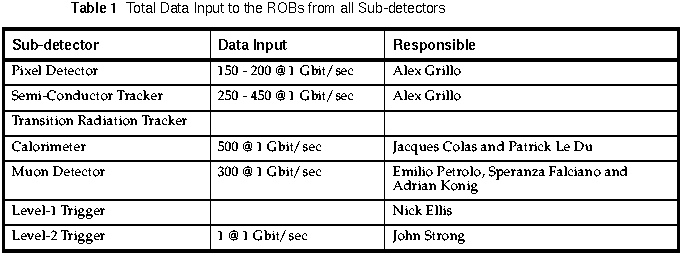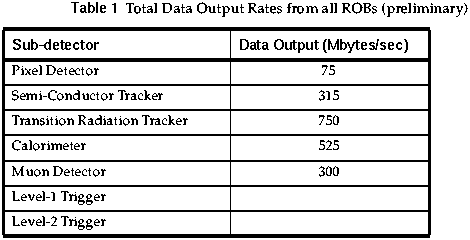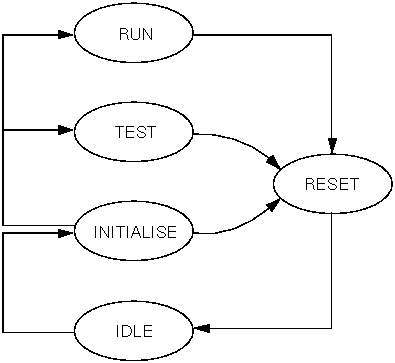
3 Specific Requirements
The Calorimeter consists of four components; the Electromagnetic Liquid Argon Calorimeter, the Hadronic Liquid Argon Calorimeter, the Forward Liquid Argon Calorimeter, and the Hadronic Scintillator Tile Calorimeter.
The Muon Detector consists of two components; the Trigger Chambers and the Precision Chambers.
Finally, although not strictly a detector, when an L1_accept signal is generated by the Level-1 Trigger system, the trigger data which led to the L1_accept is fed into the dataflow and appended to the event.
The Total Data Input to the ROBs from the sub-detectors is given in Table 3
.
UR DI-RATE Fragment Arrival Rate
The ROB shall be able to handle a fragment arrival rate of up to 100 kHz without deadtime losses. Incoming fragments will not be de-randomised in time and so, at peak times, fragments can arrive immediately following each other. However, there are some limitations and, in particular, there can be no more than 16 fragments in any 16 ms period.
Need
Essential.
Priority
Prototype.
Stability
Unlikely to change.
Source
Level-1 Trigger and Front-end.
Clarity
Clear.
Verifiability
To be tested during prototype -1 program.
The ROB shall be able to receive event fragments of various sizes as described in Table 4
Need
Essential.
Priority
Prototype.
Stability
Fragment sizes will change as experiment develops.
Source
Front-end.
Clarity
Clear.
Verifiability
To be tested during prototype -1 program.
The Read-out Link will transfer data to the ROB at a rate of 100 MByte/sec. The ROB shall be able to handle such an input data rate.
Need
Essential.
Priority
Prototype.
Stability
The input data rate may increase.
Source
Front-end.
Clarity
This rate is the peak rate which is attained during actual data transfers. There may be idle periods between the transfer of fragments when no data is transferred and so the average rate may be lower. However, there is no implication of idle periods - the ROLs could transfer data continuously.
Verifiability
To be tested during prototype -1 program.
The ROB must be able to control the flow of input data on the Read-out Link in the event that its buffer becomes full.
Need
Essential.
Priority
Prototype. It is desirable that both strategies noted below (XOFF and L1_inhibit) be implemented in the prototype.
Stability
The flow control mechanism may change.
Source
Dataflow.
Clarity
Flow control could be implemented by a signal to the Read-out Link (XOFF) causing it to stop transfers or by a signal to the Level-1 Trigger (L1_inhibit) causing it to stop issuing L1_accepts.
Verifiability
To be tested during prototype -1 program.
Data sent from the front-ends may be compressed before transmission. Since the ROB may be required to reformat and pre-process the data, it may have to apply expansion to data coming in from the ROD. This would only be performed on fragments which were selected by an RoI_request.
Need
Negotiable.
Priority
Final system.
Stability
This requirement may change or be removed.
Source
Level-2 Trigger.
Clarity
No expansion algorithms have been defined.
Verifiability
To be decided.
UR DI-ALLO Buffer Space Allocation
The ROB must allocate a buffer space for each incoming fragment. The ROB can read the event_ID in the header of the event and also can cross-check this with TTC_IDs (event_ID plus bunch_crossing_ID) generated by the TTC receiver board which is accessible by the ROB.
Need
Essential.
The ROB must be able to store incoming fragments until the Level-2 Trigger has issued an L2_accept or L2_reject. It must, thereafter, continue to store accepted fragments until they have been sent to Level-3. The minimum buffer size is given by:
BS: Buffer Size
EFS: Event Fragment Size
FAR: Fragment Arrival Rate
L2pt: Level-2 Trigger processing time (time to get an L2_accept or L2_reject)
L2ar: Level-2 Trigger accept rate (rate of L2_accepts)
L3rt: Level-3 Trigger read-out time (includes event building time)
SF: Safety Factor to be derived from modelling
Need
Essential.
UR L2-ROI
RoI_request Handling
The ROB must receive an RoI_request and use it to select either RoI_data or the full fragment from memory. This data is then sent to the Level-2 Trigger. The RoI_request may also contain parameters which define further processing which may be required on the fragment. These are described in the following URs.
Need
Essential.
UR L2-REF
RoI_data Reformatting
The ROB may have to reformat the RoI_data before transmission to the Level-2 Trigger.
Need
Negotiable.
UR L2-PRE
RoI_data Pre-processing
The ROB may have to pre-process the data before transmission to the Level-2 Trigger.
Need
Negotiable.
UR L2-COMP
RoI_data Compression
The ROB may have to apply compression to data before sending it to the Level-2 Trigger.
Need
Negotiable.
The Level-2 Trigger generates an L2_reject signal for unwanted fragments which should cause the ROB to release the buffer space relating to that fragment.
Need
Essential.
For selected fragments, the ROB receives an L2_accept which causes it to retain the fragment in memory until the data has been transferred to the Level-3 Trigger.
Need
Essential.
UR L3-REF
Level-3 Data Reformatting
The ROB may have to reformat the data before transmission to the Event Builder.
Need
Negotiable.
UR L3-PRE
Level-3 Data Pre-processing
The ROB may have to pre-process the data before transmission to the Event Builder.
Need
Negotiable.
UR L3-COMP
Level-3 Data Compression
The ROB may have to apply compression to data before sending it to the Event Builder.
Need
Negotiable.
UR L3-DAH
Level-3 Destination_address Handling
Para to be supplied.
Priority
On an L2_accept or an L3_request, the ROBs must pass the event fragment to the Event Builder. An indication of the total Data Output Rates from all ROBs is given in Table 5
Need
Essential.
The ROB may have to wait for successful completion of the data transfer to the Level-3 Trigger before deleting an accepted fragment from memory (i.e. it may have to wait for an L3_done or until local data collection has completed).
Need
Negotiable.
The ROB must respond to commands from Run Control. These will consist of commands to change to one of a series of defined states. An example of a series of states and allowed transitions is given in Figure 3.
Figure 3 Example of states and transitions in the ROB.
Need
Essential.
The ROB will be configured on power-up by an external controller. This controller could load programs and parameters.
Need
Essential.
Each time a trigger is issued, the ROB must receive, from the TTC or its interface module, the event_ID, the bunch_crossing_ID and the trigger type.
Need
Negotiable.
UR ERR-TRANS
Transmission Error
The ROB must be able to detect a transmission error. This is when a data error occurs during transmission over the ROL.
Need
Essential.
UR ERR-FBIG
Fragment Too Big Error
The ROB must be able to detect and respond if the front-end sends a fragment which is bigger than a pre-defined "maximum fragment size".
Need
Essential.
UR ERR-FERR
Fragment Contains Error
The ROB may have to be able to detect if an incoming fragment has an error flag set by the ROD (i.e. the fragment already contains an error before transmission to the ROB). Note that this is not the same as UR ERR-TRANS.
Need
Negotiable.
The ROB must be able to monitor all kinds of error conditions and keep statistics.
Need
Negotiable.
The ROB must recognise and recover from the set of dataflow error conditions defined in Table 6
Need
Essential.
The ROB must be able to be `rebooted' without interrupting data-taking. The ROB should regain synchronisation by making use of the event_ID and bunch_crossing_ID and rejoin the data flow.
Need
Essential.
UR GBL-MON
Monitor Data Handling
The ROB must respond to user request to send selected data to a parallel (to the dataflow) server for monitoring of data quality. User requests will take the form of random or occasional tagging of events which must then be packaged and sent along the monitoring data path.
The fragments could be selected according to event_ID, bunch_crossing_ID, Level-1 trigger type, Level-2 Trigger type, etc.
Data monitoring should not introduce latency or dead-time in the data flow.
Need
Negotiable.
UR GBL-DTST
Dataflow Test Mode
The ROB must be able to function in three dataflow test modes;
The ROB must be able to carry out a test of its communications with all external systems such as the Run Control, the TTC, the Monitor system, Level-2 Trigger, Level-3 Trigger, etc.
Need
Negotiable.
UR GBL-HIST
History Maintenance
The ROB must keep a history record of all signals and messages received.
Need
Negotiable.
UR GBL-PERF
Performance Recording
The ROB must maintain statistics on performance parameters such as buffer occupancy.
Need
Negotiable.
The ROB must be accessible from an external processor for monitor and control.
Need
Essential.
On request, the ROB must carry out self-tests and report the results to some other system.
Need
Negotiable.
Generated with CERN WebMaker
Priority
Prototype.
Stability
Size of buffer required may change.
Source
Dataflow.
Clarity
Clear.
Verifiability
To be decided.
3.1.2 Level-2 Trigger Requirements
![]()
Priority
Prototype.
Stability
All parameters in the equation are likely to change therefore the buffer size is likely to change.
Source
Dataflow.
Clarity
It has to be decided whether the parameters in the calculation are minimum, maximum or average.
Verifiability
To be decided.
Priority
Prototype.
Stability
The amount of RoI_data required could vary from a subset of the fragment to the full fragment.
Source
Level-2 Trigger.
Clarity
It is not yet defined how the RoI_request will be received: via a broadcast system which could be shared with the TTC or, via a separate bi-directional data channel that connects the ROB to Level-2 or, via a local bus connecting several ROBs to an interface module.
Verifiability
To be verified during the prototype -1 program.
Priority
Final system.
Stability
The initial and final data formats may change.
Source
Dataflow.
Clarity
No data formatting algorithms have been defined.
Verifiability
To be decided.
Priority
Final system.
Stability
The initial and final data formats may change.
Source
Dataflow.
Clarity
No data formatting algorithms have been defined.
Verifiability
To be decided.
Priority
Final system.
Stability
The initial and final data formats may change.
Source
Dataflow.
Clarity
No data formatting algorithms have been defined.
Verifiability
To be decided.
Priority
Prototype.
Stability
Unlikely to change.
Source
Level-2 Trigger.
Clarity
The L2_reject signals may be accumulated by Level-2 and so may arrive at the ROB in batches of 100 or so. This has some implications for the buffer size calculation.
Verifiability
To be verified during the prototype -1 program.
Priority
Prototype.
Stability
Unlikely to change.
Source
Level-2 Trigger.
Clarity
The protocol with Level-3, which ensures that a fragment has been successfully transferred, has yet to be defined.
Verifiability
To be verified during the prototype -1 program.
3.1.3 Level-3 Trigger and Event Builder Requirements
Priority
Final system.
Stability
The initial and final data formats may change.
Source
Dataflow.
Clarity
No data formatting algorithms have been defined.
Verifiability
To be decided.
Priority
Final system.
Stability
The initial and final data formats may change.
Source
Dataflow.
Clarity
No data processing algorithms have been defined.
Verifiability
To be decided.
Priority
Final system.
Stability
The initial and final data formats may change.
Source
Dataflow.
Clarity
No data compression algorithms have been defined.
Verifiability
To be decided.
Stability
Source
Livio Mapelli
Clarity
Verifiability

Priority
Prototype.
Stability
Unlikely to change.
Source
Level-3 Trigger.
Clarity
It is not clear whether L2_accept and L3_request are the same thing. There may not be a one-to-one mapping between them.
Verifiability
To be verified during the prototype -1 program.
Priority
Final system.
Stability
This requirement may change if the dataflow architecture is changed.
Source
Dataflow.
Clarity
Clear.
Verifiability
To be decided.
3.1.4 Run Control Requirements

Priority
Final system.
Stability
The states and state changes required will change frequently.
Source
Run Control.
Clarity
None of the states have been defined.
Verifiability
To be decided.
Priority
Prototype.
Stability
The amount and nature of the data to be transferred to the ROB during the configuration is likely to change frequently.
Source
Run Control.
Clarity
The configuration data depends heavily on the hardware used for the ROB.
Verifiability
To be decided.
3.1.5 Timing, Trigger and Control Requirements
Priority
Final system.
Stability
The format and amount of data may change.
Source
TTC.
Clarity
Clear.
Verifiability
To be decided.
3.1.6 Error Handling
Priority
Final system.
Stability
Unlikely to change.
Source
Front-end.
Clarity
The action has to be decided. This could be to add an error flag to the fragment or to signal (somehow) to the ROL to re-transmit
Verifiability
To be decided.
Priority
Final system.
Stability
Unlikely to change.
Source
Front-end.
Clarity
The action has not been defined. This could be to truncate the fragment and add a flag or to send an error fragment instead.
Verifiability
To be decided.
Priority
Final system.
Stability
Unlikely to change.
Source
Front-end.
Clarity
It may not be necessary for the ROB to detect this. The error flag will be contained in the fragment and so, as long as it is transmitted intact when the fragment is passed on, the ROB may not need to be aware of it.
Verifiability
To be decided.
Priority
Possibly prototype only.
Stability
Errors to be monitored and statistics to be accumulated may change frequently.
Source
Dataflow.
Clarity
Errors to be monitored and statistics to be accumulated have not been defined.
Verifiability
To be decided.

Priority
Final system.
Stability
Additional error conditions are likely to appear. Actions on existing error conditions may change.
Source
Dataflow.
Clarity
Clear.
Verifiability
To be decided.
Priority
Final system.
Stability
Unlikely to change.
Source
Dataflow.
Clarity
This would require a start_of_event marker in the fragment to allow the ROB to re-start cleanly.
Verifiability
To be decided.
3.1.7 Global System Requirements
Priority
Final system.
Stability
Data required and selection criteria are likely to change frequently.
Source
Dataflow.
Clarity
The user may need to receive all fragments relating to a particular event from all ROBs.
Verifiability
To be decided.
Need
Negotiable.
Priority
Final system.
Stability
Data patterns used in test mode may change frequently.
Source
Dataflow.
Clarity
Clear.
Verifiability
To be decided.
Priority
Final system.
Stability
Test to be run may change.
Source
All external systems.
Clarity
Clear.
Verifiability
To be decided.
Priority
Possibly only in prototype.
Stability
Items to be recorded may change.
Source
Dataflow.
Clarity
It is not clear how this could be done.
Verifiability
To be decided.
Priority
Final system.
Stability
Statistics required may change.
Source
Dataflow.
Clarity
It is not clear how this data is to be accessed.
Verifiability
To be decided.
Priority
Prototype.
Stability
Type of interface may change.
Source
Dataflow.
Clarity
It is not clear what commands will be issued from the processor.
Verifiability
To be decided.
Priority
Possibly only in prototype.
Stability
This requirement may be removed.
Source
Dataflow.
Clarity
The tests required have not been defined.
Verifiability
To be decided.
Issue: 1.2 - Revision: 0 - Last Modified: 18 June 1996
[Next] [Previous] [Up] [Top] [Contents]